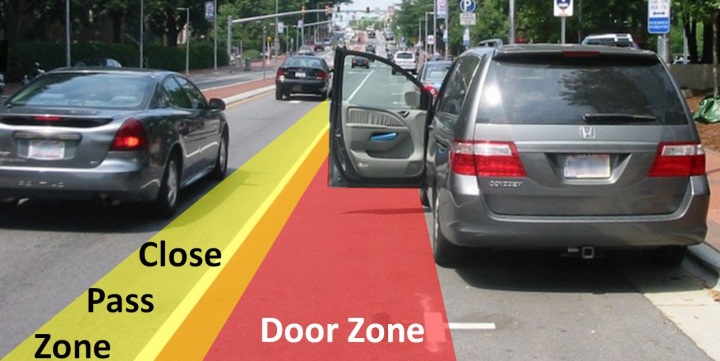6. Speed Positioning between Intersections
Slower drivers operate closer to the curb; faster drivers operate closer to the center of the road and pass slower traffic on the left. Where lanes are marked, slower drivers use the rightmost lane that serves their destination. Where lanes are not marked, slower drivers operate as far right as is safe and practical. (See § 20-146(b).)
Some roads feature marked travel lanes that are wide enough for motorists to pass cyclists at a safe distance within the same lane lane. This requires at least 14 feet of usable pavement for passing by an SUV, and at least 16 feet for passing by a truck or bus. Bicyclists may sometimes ride far enough right to facilitate same-lane passing as a courtesy on such roads. However, most travel lanes are only 10-12 feet wide, too narrow for safe same-lane passing, as shown below.
[Graphics: i am traffic]
In typical, narrow travel lanes, riding at the right edge encourages drivers to attempt passing within the same lane. Drivers may misjudge conditions and not realize how narrow the available space is until it’s too late, especially when they are approaching at high speed. The most common type of car-overtaking-bicyclist crash involves a driver who sees the bicyclist riding at the right edge of a narrow lane with plenty of advance notice, but attempts to squeeze within the same by at high speed. In a narrow travel lane, it’s usually safer for the cyclist to ride far enough into the lane to make it clear to motorists that they must move into the adjacent lane to pass.
[Graphic: Keri Caffrey, i am traffic]
When it becomes safe to pass, a bicyclist can encourage a following driver to pass by moving to the right, a technique called “control and release” [see this video]. If other traffic backs up for a long time without a safe opportunity to pass, a courteous cyclist can look for a place to stop and pull off the roadway to help it disperse.
Avoid the door zone: Stay at least 5 feet away from parked cars to avoid being doored. It’s unlikely that you’ll be able to stop in time when someone opens a car door right in front of you, and you won’t have time to merge left safely. On some streets avoiding the door zone means you’ll be using an entire travel lane, but you’re allowed to do so to avoid the greater danger of suddenly striking an open door and being thrown left into traffic, or swerving left in an evasive maneuver. In either event, other drivers won’t have time to respond, but if you ride a straight line outside of the door zone, you won’t surprise other drivers.
On urban streets with on-street parking, the center of the right hand travel lane is the safest default position for bicycling. Drivers can usually pass using the adjacent lane with minimal delay. If road and traffic conditions prevent this, and traffic backs up for an uncomfortably long time, you can look for a safe place to pull over and let those drivers pass you as a courtesy. This is much safer than riding at the right edge under narrow conditions that invite squeeze-by passing.




